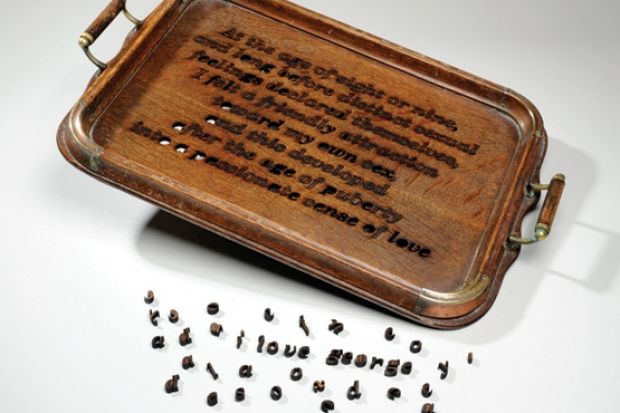Other Stories: Queering the University Art Collection
Stanley & Audrey Burton Gallery
University of Leeds
February to 5 May
Bernard Meninsky's Mother and Child, painted in 1919, is a touching image of a woman breastfeeding in a bedroom. Next to it, the artist Matt Smith has hung two vintage christening dresses embroidered with the reflections of a lesbian recorded in 2000. Although she would "really like to be a parent", she says, "I don't think I would want to be the one that has to give birth. One advantage of a gay couple might be that the other one can do that. That might be quite a good idea - you can draw straws for it."
For LGBT (Lesbian, Gay, Bisexual, Transgender) History Month, the Stanley & Audrey Burton Gallery in Leeds is mounting a two-part exhibition. One strand is devoted to the Victorian gay rights campaigner, pacifist and advocate of "the simple life", Edward Carpenter (1844-1929), whose papers are held in the university library's special collections. For the other, Smith has produced eight separate "interventions" in the permanent collection.
Each is a domestic object inscribed in some way with a testimony of gay life from the Brighton Ourstory archive. And each is juxtaposed with a painting, drawing or photograph already on display. His aim, explains Smith, is to "repurpose the collection in terms of the oral histories that would normally be discounted".
There are stories of satisfied desire, blossoming romance and even a surprisingly tender description by a young sex worker of an "old queen" who had become "like the family I never had" ("I call him Grandma and he calls me Cheryl"). But there are also harrowing accounts of the time before male homosexuality was legalised in 1967, when anonymous one-night stands were safer than even the most secretive "steady affair", and when a boy spent three years in jail after his father reported him to the police.
These reminiscences are cut into a Victorian tray, written into an old address book, engraved into an Art Deco photo frame or Babycham glasses, often to startling and discordant effect. Looking back to the 1980s, Smith recalls "the constant cleaning and caring of people with Aids. The sheer repetition altered one's sense of time." In one of his "interventions", he has attempted to create a "transient memorial" to the losses of that era, carving a terrible description of the ravages of the disease into a huge marble-like slab of soap.
"Unlike most other minority groups - those linked by religion, ethnicity and race," he notes in the catalogue, "the LGBT community produces a paucity of unique material culture. There are few 'gay objects'. It is also a group which seldom passes knowledge down through familial, intergenerational links." By "queering" the Leeds collection, he has attempted to challenge that situation.
Register to continue
Why register?
- Registration is free and only takes a moment
- Once registered, you can read 3 articles a month
- Sign up for our newsletter
Subscribe
Or subscribe for unlimited access to:
- Unlimited access to news, views, insights & reviews
- Digital editions
- Digital access to THE’s university and college rankings analysis
Already registered or a current subscriber? Login
